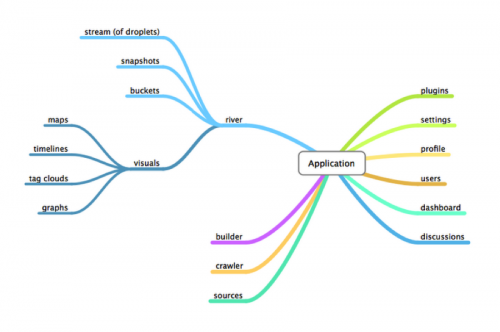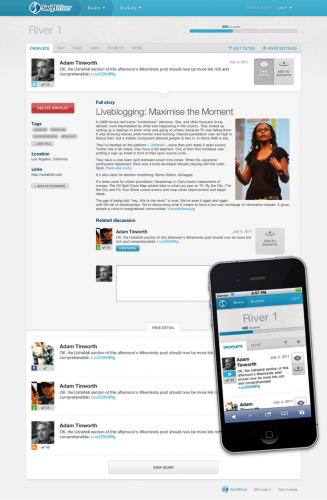(The original post appeared on the MediaShift / Knight Projects: IdeaLab, December 9, 2011.)
There’s a problem that constantly plagues us in this day of information overload, and that is the ability to sift the stream of incoming information into the bits that are valuable from those that aren’t. It’s a tough issue that we’ve been working on at Ushahidi, and re-working, a solution on for a while now. Our solution is called SwiftRiver.
SwiftRiver is a free and open source intelligence platform that helps people curate and make sense of large amounts of information in a short amount of time. In practice, SwiftRiver enables the filtering and verification of real-time data from channels such as SMS, Email, Twitter and RSS feeds. It's especially useful for organizations who need to sort their data by their unique expectations of authority and accuracy, as opposed to popularity. Such organizations include journalists, community based-organizations, PR/marketing, emergency responders, election monitoring groups and more.

 As mentioned earlier, SwiftRiver will be available in the coming weeks. We will release the roadmap, a new look and feel, and provide an outline on how you can contribute to the next Swift. You can connect to the Swift community via our google group: swiftriver@googlegroups.com
As mentioned earlier, SwiftRiver will be available in the coming weeks. We will release the roadmap, a new look and feel, and provide an outline on how you can contribute to the next Swift. You can connect to the Swift community via our google group: swiftriver@googlegroups.com
SwiftRiver, In Plain English
There's a torrential river of information that's constantly flowing on the Internet. If you dive into that river in search of something, chances are you'd drown. Now before we go any further, let's first define this river of information. Simply, the "river" is made up by billions of bits of information. In the context of SwiftRiver, we call these things "droplets." For example, common droplets in the river are tweets, Facebook updates, and blog posts. These are common examples, but by definition, things like text messages, emails, and even rows in a database table are considered droplets, too. So how does SwiftRiver help you make sense of all these droplets? Well, it analyzes droplets much like your brain analyzes the world around you. For example, when you look at a kitchen table, your brain instantly determines its color, height, location and texture. In the same way, when SwiftRiver looks at a droplet, it determines all its attributes. For example, if SwiftRiver looks at a tweet, it can determine things like location, time, author and meaning (in the form of keywords). Generally speaking, SwiftRiver does this using a process known as "natural language processing." Once SwiftRiver analyzes all the droplets, you then have the ability to filter them down from that torrential river to a manageable stream. In addition to filtering, you can run different analyses on them, helping you get the "big picture" of your set of droplets.
SwiftRiver Glossary of Terms
Droplet: The basic unit of content inside SwiftRiver, i.e., a tweet, a Facebook update, a blog post, an SMS text message, etc. Identity: The originator of a droplet from a specific channel, i.e., a Twitter account, a Facebook account, a phone number, an email address. Identities are automatically extracted when a droplet is "siphoned" from a channel. Source: Comprises one or more identities, and could be a person or organization. Unlike identities that are automatically extracted, sources are subjective and put together by users in the system. Channel: The vehicle for transporting a droplet into the river, i.e., RSS, SMS, Twitter, JSON, XML, etc. River: The torrent of droplets that come from the predefined channels. Filter: The mechanism for reducing a channel or river from a torrent of droplets to a more manageable set. Stream: A collection of droplets whose contents are defined by a filter or a combination of filters. Bucket: A group of hand-picked droplets from a stream. Trends: A narrative based on the droplets in a bucket. Components: description, time, sources, places, media (links), tags, theme.Types of stories, i.e., outputs:
- Text
- Maps
- Timeline
- Graphs, Charts, Heatmaps
- Gallery: Photos, Video, Audio
A sneak peak at the rebooted platform
Since the end of this summer, the Ushahidi team has been focused on rebuilding much of the platform so that it would dovetail perfectly with the Ushahidi core platform and Crowdmap. So, it's a standalone application that anyone can access and use by itself, but it also answers our users' need for a faster, more nimble way to manage information flow on their deployments. Back in August, we completed the first iteration of our ID and authentication system, RiverID, the first step needed for us to have a collaborative profile-based tool for SwiftRiver services. In October, we locked four of the Ushahidi team, made up of two designers and two engineers, away in a cabin, deep in the woods of Georgia. Their job: Do two months' worth of work in six days. This they did. While we haven't released the code yet, the beta will be available in mid-December (three weeks) for the community first, then for the general review. But, in an effort to quench your curiosity, here's a sneak peak via screenshot. :) As mentioned earlier, SwiftRiver will be available in the coming weeks. We will release the roadmap, a new look and feel, and provide an outline on how you can contribute to the next Swift. You can connect to the Swift community via our google group: swiftriver@googlegroups.com
As mentioned earlier, SwiftRiver will be available in the coming weeks. We will release the roadmap, a new look and feel, and provide an outline on how you can contribute to the next Swift. You can connect to the Swift community via our google group: swiftriver@googlegroups.com